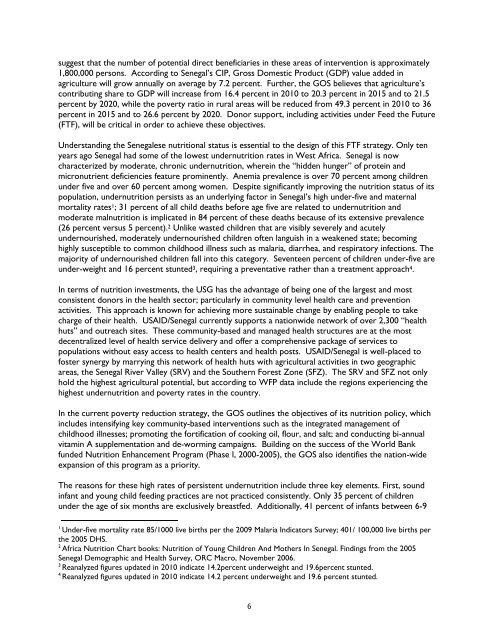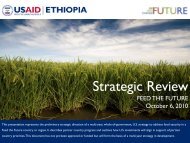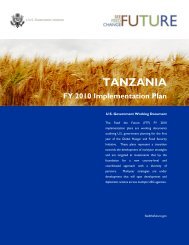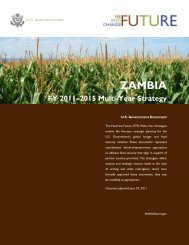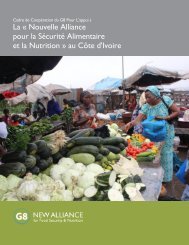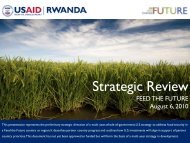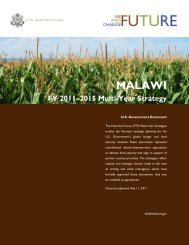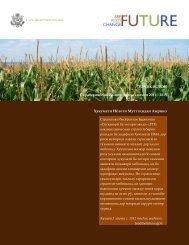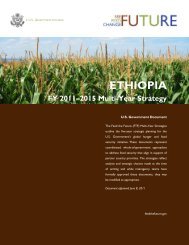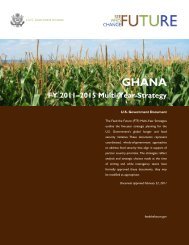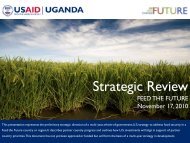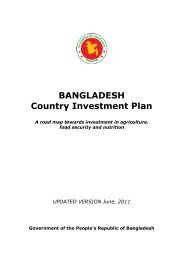Feed the Future Multi-Year Strategy, Senegal, Public
Feed the Future Multi-Year Strategy, Senegal, Public
Feed the Future Multi-Year Strategy, Senegal, Public
You also want an ePaper? Increase the reach of your titles
YUMPU automatically turns print PDFs into web optimized ePapers that Google loves.
suggest that <strong>the</strong> number of potential direct beneficiaries in <strong>the</strong>se areas of intervention is approximately<br />
1,800,000 persons. According to <strong>Senegal</strong>’s CIP, Gross Domestic Product (GDP) value added in<br />
agriculture will grow annually on average by 7.2 percent. Fur<strong>the</strong>r, <strong>the</strong> GOS believes that agriculture’s<br />
contributing share to GDP will increase from 16.4 percent in 2010 to 20.3 percent in 2015 and to 21.5<br />
percent by 2020, while <strong>the</strong> poverty ratio in rural areas will be reduced from 49.3 percent in 2010 to 36<br />
percent in 2015 and to 26.6 percent by 2020. Donor support, including activities under <strong>Feed</strong> <strong>the</strong> <strong>Future</strong><br />
(FTF), will be critical in order to achieve <strong>the</strong>se objectives.<br />
Understanding <strong>the</strong> <strong>Senegal</strong>ese nutritional status is essential to <strong>the</strong> design of this FTF strategy. Only ten<br />
years ago <strong>Senegal</strong> had some of <strong>the</strong> lowest undernutrition rates in West Africa. <strong>Senegal</strong> is now<br />
characterized by moderate, chronic undernutrition, wherein <strong>the</strong> “hidden hunger” of protein and<br />
micronutrient deficiencies feature prominently. Anemia prevalence is over 70 percent among children<br />
under five and over 60 percent among women. Despite significantly improving <strong>the</strong> nutrition status of its<br />
population, undernutrition persists as an underlying factor in <strong>Senegal</strong>’s high under-five and maternal<br />
mortality rates 1 ; 31 percent of all child deaths before age five are related to undernutrition and<br />
moderate malnutrition is implicated in 84 percent of <strong>the</strong>se deaths because of its extensive prevalence<br />
(26 percent versus 5 percent). 2 Unlike wasted children that are visibly severely and acutely<br />
undernourished, moderately undernourished children often languish in a weakened state; becoming<br />
highly susceptible to common childhood illness such as malaria, diarrhea, and respiratory infections. The<br />
majority of undernourished children fall into this category. Seventeen percent of children under-five are<br />
under-weight and 16 percent stunted 3 , requiring a preventative ra<strong>the</strong>r than a treatment approach 4 .<br />
In terms of nutrition investments, <strong>the</strong> USG has <strong>the</strong> advantage of being one of <strong>the</strong> largest and most<br />
consistent donors in <strong>the</strong> health sector; particularly in community level health care and prevention<br />
activities. This approach is known for achieving more sustainable change by enabling people to take<br />
charge of <strong>the</strong>ir health. USAID/<strong>Senegal</strong> currently supports a nationwide network of over 2,300 “health<br />
huts” and outreach sites. These community-based and managed health structures are at <strong>the</strong> most<br />
decentralized level of health service delivery and offer a comprehensive package of services to<br />
populations without easy access to health centers and health posts. USAID/<strong>Senegal</strong> is well-placed to<br />
foster synergy by marrying this network of health huts with agricultural activities in two geographic<br />
areas, <strong>the</strong> <strong>Senegal</strong> River Valley (SRV) and <strong>the</strong> Sou<strong>the</strong>rn Forest Zone (SFZ). The SRV and SFZ not only<br />
hold <strong>the</strong> highest agricultural potential, but according to WFP data include <strong>the</strong> regions experiencing <strong>the</strong><br />
highest undernutrition and poverty rates in <strong>the</strong> country.<br />
In <strong>the</strong> current poverty reduction strategy, <strong>the</strong> GOS outlines <strong>the</strong> objectives of its nutrition policy, which<br />
includes intensifying key community-based interventions such as <strong>the</strong> integrated management of<br />
childhood illnesses; promoting <strong>the</strong> fortification of cooking oil, flour, and salt; and conducting bi-annual<br />
vitamin A supplementation and de-worming campaigns. Building on <strong>the</strong> success of <strong>the</strong> World Bank<br />
funded Nutrition Enhancement Program (Phase I, 2000-2005), <strong>the</strong> GOS also identifies <strong>the</strong> nation-wide<br />
expansion of this program as a priority.<br />
The reasons for <strong>the</strong>se high rates of persistent undernutrition include three key elements. First, sound<br />
infant and young child feeding practices are not practiced consistently. Only 35 percent of children<br />
under <strong>the</strong> age of six months are exclusively breastfed. Additionally, 41 percent of infants between 6-9<br />
1<br />
Under-five mortality rate 85/1000 live births per <strong>the</strong> 2009 Malaria Indicators Survey; 401/ 100,000 live births per<br />
<strong>the</strong> 2005 DHS.<br />
2<br />
Africa Nutrition Chart books: Nutrition of Young Children And Mo<strong>the</strong>rs In <strong>Senegal</strong>. Findings from <strong>the</strong> 2005<br />
<strong>Senegal</strong> Demographic and Health Survey, ORC Macro, November 2006.<br />
3<br />
Reanalyzed figures updated in 2010 indicate 14.2percent underweight and 19.6percent stunted.<br />
4<br />
Reanalyzed figures updated in 2010 indicate 14.2 percent underweight and 19.6 percent stunted.<br />
6


